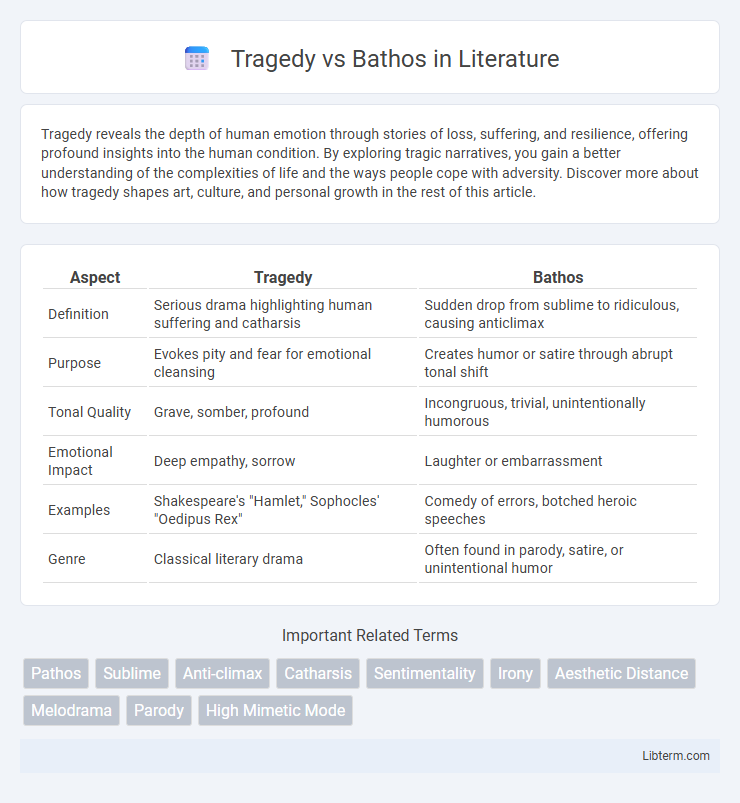Tragedy reveals the depth of human emotion through stories of loss, suffering, and resilience, offering profound insights into the human condition. By exploring tragic narratives, you gain a better understanding of the complexities of life and the ways people cope with adversity. Discover more about how tragedy shapes art, culture, and personal growth in the rest of this article.
Table of Comparison
| Aspect | Tragedy | Bathos |
|---|---|---|
| Definition | Serious drama highlighting human suffering and catharsis | Sudden drop from sublime to ridiculous, causing anticlimax |
| Purpose | Evokes pity and fear for emotional cleansing | Creates humor or satire through abrupt tonal shift |
| Tonal Quality | Grave, somber, profound | Incongruous, trivial, unintentionally humorous |
| Emotional Impact | Deep empathy, sorrow | Laughter or embarrassment |
| Examples | Shakespeare's "Hamlet," Sophocles' "Oedipus Rex" | Comedy of errors, botched heroic speeches |
| Genre | Classical literary drama | Often found in parody, satire, or unintentional humor |
Understanding Tragedy: Definition and Origins
Tragedy, originating from ancient Greek theater, is a dramatic genre that explores human suffering and moral dilemmas, often leading to a cathartic experience for the audience. Key figures like Aristotle defined tragedy through elements such as plot, character, and hamartia, emphasizing its purpose in evoking pity and fear. This foundational understanding distinguishes tragedy from bathos, where the latter subverts emotional gravity by introducing sudden anticlimax or absurdity.
Defining Bathos: Meaning and Historical Context
Bathos is a literary term describing an abrupt shift from the sublime or serious to the trivial or comedic, often resulting in unintentional humor or anticlimax. Originating from the Greek word meaning "depth," the concept gained prominence through Alexander Pope's 18th-century satirical essay "Peri Bathous," which critiqued failed attempts at pathos in poetry and drama. Bathos contrasts with tragedy by undermining emotional intensity and gravitas, transforming moments meant to inspire profound feeling into farcical or absurd scenarios.
Key Differences Between Tragedy and Bathos
Tragedy presents a serious and somber narrative that evokes pity and fear through noble characters facing inevitable doom, whereas bathos results in an abrupt shift from the sublime to the ridiculous, generating unintentional or exaggerated humor. Key differences include tone, with tragedy maintaining a dignified and elevated style, while bathos undermines seriousness by descending into anticlimax or absurdity. Tragedy aims to provoke catharsis and deep emotional reflection, but bathos produces a humorous or deflating effect by undercutting the gravity of a situation.
The Role of Emotion in Tragedy and Bathos
Tragedy evokes profound emotional responses such as pity and fear, drawing audiences into the suffering and moral dilemmas of characters to achieve catharsis. Bathos, in contrast, deliberately undermines or exaggerates emotional appeal, creating an anticlimax that shifts feelings from seriousness to absurdity or humor. The role of emotion in tragedy is to deepen empathy and reflection, while in bathos, it serves to disrupt or parody sincere sentiment.
Literary Devices: Tragedy vs Bathos Techniques
Tragedy employs literary devices such as catharsis, dramatic irony, and elevated diction to evoke profound emotions and highlight human suffering. Bathos, in contrast, uses intentional anticlimax, exaggerated sentimentality, and absurd imagery to create a comical or ludicrous effect that undermines serious moments. The juxtaposition of these techniques distinguishes tragedy's solemn gravity from bathos' comedic deflation.
Examples of Tragedy in Classic Literature
Classic literature showcases tragedy through works like Sophocles' "Oedipus Rex," where the protagonist's fatal flaw leads to irreversible doom, and Shakespeare's "Hamlet," depicting the prince's struggle with revenge and madness culminating in a tragic downfall. In Euripides' "Medea," intense emotional conflict and betrayal result in catastrophic consequences, exemplifying profound tragic themes. These examples highlight the gravity and catharsis central to traditional tragedy, contrasting sharply with the emotional anticlimax found in bathos.
Spotting Bathos in Modern Writing
Spotting bathos in modern writing involves recognizing an unintentional shift from serious or elevated themes to trivial or absurd elements that undermine the intended emotional impact. Bathos often manifests through abrupt changes in tone, cliched expressions, or forced humor that clashes with the narrative's gravity. Understanding this contrast helps readers discern genuine tragedy from unintended comedic effects in contemporary literature and media.
The Impact of Tragedy vs Bathos on Audience Reception
Tragedy evokes profound emotional responses by highlighting human suffering and existential dilemmas, fostering empathy and introspection among audiences. Bathos, often characterized by an abrupt shift from the serious to the ludicrous, disrupts emotional engagement, leading to amusement or disappointment rather than catharsis. The contrasting effects of tragedy and bathos shape audience reception by either deepening emotional impact or undermining narrative seriousness, influencing overall perception and memorability of a performance.
Avoiding Bathos: Tips for Writers
Writers can avoid bathos by maintaining consistent tone and emotional depth throughout their work, ensuring that dramatic moments remain sincere and impactful. Focusing on authentic character development and avoiding sudden, unwarranted shifts to triviality helps preserve the gravity essential to tragedy. Careful editing to remove unintended humor or exaggeration strengthens the narrative's emotional resonance and prevents undermining the story's seriousness.
Tragedy and Bathos in Popular Culture
Tragedy in popular culture often portrays profound human suffering and moral dilemmas, evoking deep emotional responses through characters' downfall and fate-driven conflicts. Bathos appears when these serious themes are unintentionally undermined by absurd, trivial, or comedic elements, creating a jarring contrast that shifts audience perception from empathy to amusement. Iconic films and literature use tragedy to explore existential questions, while bathos is frequently employed in parody or satire to critique or lighten the heavy tone of tragic narratives.
Tragedy Infographic

 libterm.com
libterm.com